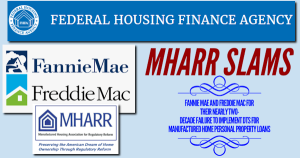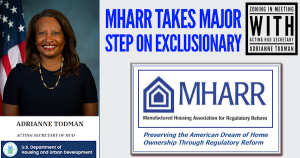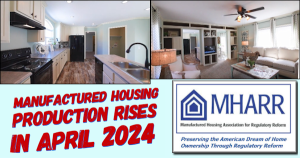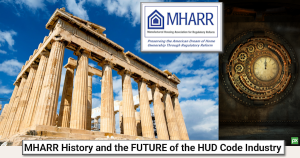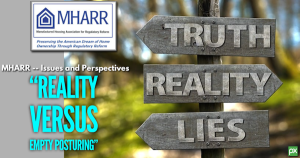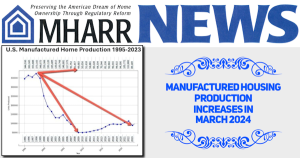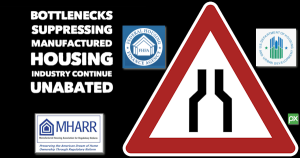MHARR September 21, 2020 WASHINGTON UPDATE — an EXCLUSIVE Manufactured Housing Report and Analysis
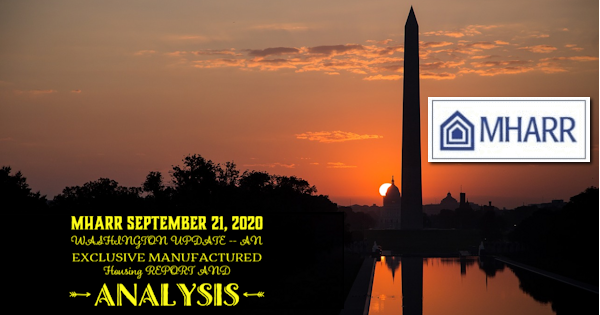
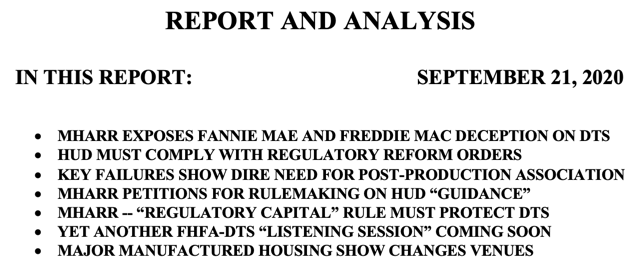
MHARR EXPOSES FANNIE AND FREDDIE DECEPTION OF REGULATORS CONGRESS AND TRUMP ADMINISTRATION ON DTS
MHARR, in a critical new dialogue with senior Federal Housing Finance Agency (FHFA) officials has demonstrated, with specific facts, information and key relevant numbers, how Fannie Mae and Freddie Mac have diverted and undermined the implementation of the Duty to Serve Underserved Markets (DTS) regarding manufactured homes, while simultaneously misleading FHFA regulators, Congress, the Trump Administration and the public. That information, including a specific cost analysis of the hybrid manufactured homes that Fannie and Freddie have targeted for support under DTS, versus mainstream, affordable HUD Code manufactured homes, illustrates how those entities, for twelve years, have distorted DTS, misusing a law and mandate designed to advance the availability of affordable housing in order to promote and advance much more costly homes – produced by one or two industry conglomerates – at prices that are not affordable for the lower and moderate-income American consumers served by mainstream manufactured housing. As a result, MHARR has called for FHFA, Fannie Mae and Freddie Mac, to totally “re-think, re-envision and revamp” their approach to the DTS mandate.
The numbers regarding DTS implementation within the manufactured housing market do not lie and paint a damning picture that has been ignored – at best – by FHFA and manipulated by others to mislead Congress, the Trump Administration, the public and the industry. To start with, FHFA’s own DTS “dashboard” shows that more than a decade after DTS’ enactment by Congress, some 94-95% of the mainstream, affordable manufactured housing market has been left completely unserved. In no small part, this failure is attributable to Fannie and Freddie’s continuing refusal to serve any part, whatsoever, of the HUD code market’s “chattel” sector of homes financed as personal property. Such homes — which typically are the most affordable HUD Code homes on the market — comprise 76% of all new manufactured housing placements, according to the latest (2019) data published by the U.S. Census Bureau. Yet, 12 years after the enactment of DTS, neither Fannie nor Freddie has a program to provide DTS support for such loans and for the lower and moderate-income consumers who need that support. The end result, according to a 2019 report by Freddie Mac, is that “more than 90%” of the manufactured home personal property loans reported in 2018 were “higher-cost originations” – thus benefitting the industry conglomerates’ captive “portfolio” lenders, which dominate the market. And this data does not even begin to capture or reflect, in any way, the numbers of lower and moderate-income Americans who are turned-down for financing – and thus excluded from the housing market entirely – because they cannot afford those higher rates.
Meanwhile, to the extent that Fannie and Freddie have implemented DTS within the manufactured housing sector at all, they have limited its reach to a small – and much more costly – sliver of the manufactured housing real estate market, and to a supposed “new class” of even more expensive hybrid manufactured homes which, according to Fannie and Freddie, are “more like” the site-built homes that they would prefer to deal with anyway. But even within this narrow sliver, only six such “new class” homes were supported by Fannie Mae in 2019 (with zero supported by Freddie Mac) and, of those, only two were eligible for DTS credit. And based on the data developed by MHARR, it is easy to see why. That data shows that while a typical 28×60 foot manufactured home would cost between $54,000 and $64,000 shipped from the manufacturer’s factory, an “MH Advantage” “new class” home of the same size, would cost more than double that amount (i.e., $121,000 to $137,000) and would not be affordable for the current manufactured housing consumers that DTS was designed and mandated to serve in market-significant numbers.
The upshot of all this is that twelve years after Congress’ adoption of DTS, the overwhelming majority of the mainstream HUD Code manufactured housing market remains completely unserved by Fannie and Freddie under DTS, as do lower and moderate-income American homebuyers, while Fannie and Freddie – with the approval and support of FHFA and the industry’s largest corporate conglomerates – employ bait and switch tactics in an effort to change the fundamental nature of both DTS and the market to something that it is not and never has been. Not surprisingly, then, while the site-built housing market has emerged from the Coronavirus Crisis with burgeoning sales numbers, manufactured home sales have remained lower than corresponding levels in 2019 which, itself, had less sales volume than 2018.
Put simply, DTS as “implemented” by Fannie Mae and Freddie Mac within the manufactured housing market has not worked and is not working for either the industry or the lower and moderate-income Americans that the industry serves and that DTS was mandated to serve by Congress. Instead of serving the HUD Code market as it exits and has existed for decades, Fannie and Freddie are attempting to misuse DTS as leverage to change a product that they do not want to support (i.e., modern, affordable, mainstream manufactured homes), and consumers (i.e. lower and moderate-income Americans) who they do not wish to help, in order to create, out of whole cloth, a higher-priced pseudo-manufactured housing market that does not exist and has never existed. Meanwhile, the overwhelming majority of the affordable manufactured housing market that does exist, is – and has been – completely ignored.
This must change. As MHARR has advised FHFA, and will further advise both the administration and Congress, Fannie and Freddie, under DTS, instead of trying to alter the HUD Code market, must serve that market as it exists in reality today. That means providing support for the overwhelming majority of present-day, affordable manufactured homes, including market significant numbers of mainstream manufactured homes financed as personal property. After more than a decade of excuses, inaction and misdirection, the time for concrete action to fully and effectively implement DTS for the mainstream HUD Code market is now.
MHARR PRESSES HUD TO COMPLY WITH REGULATORY REFORM ORDERS
With less than two months remaining before the 2020 presidential election, MHARR has stepped-up ongoing efforts to press for full HUD compliance with President Trump’s regulatory reform policies as enunciated in Executive Orders (EO) 13771 (“Reducing Regulation and Controlling Regulatory Costs”) and 13777 (“Enforcing the Regulatory Reform Agenda”). While these orders and the regulatory reform policies that they reflect pertain to all HUD program offices, they apply with particular force to the HUD Office of Manufactured Housing Programs (OMHP), which was expressly directed by HUD Secretary Ben Carson and Acting Assistant HUD Secretary (at the time) Dana Wade, in 2018, to conduct a complete “top-to-bottom” review of all HUD manufactured housing standards, regulations and related administrative actions. Compliance with these mandates, however, has been caught up in – and stymied by – the OMHP regulatory maze showing, yet again, what happens in the absence of an appointed non-career manufactured housing program administrator, as provided by the Manufactured Housing Improvement Act of 2000.
To date, then, even after an extended Manufactured Housing Consensus Committee (MHCC) review of literally hundreds of proposed reforms, not a single standard or regulation has been rescinded or modified by the program. Indeed, the only so-called “regulatory reform” accomplished by OMHP, in nearly three years (other than the re-assignment of former administrator Pamela Danner), has been the “withdrawal” of a number of OMHP’s ironically-named Pamela Danner-era “The Facts” public relations newsletters from the OMHP website in 2019. That action, however, is not a “regulatory” reform at all, insofar as the newsletters, per se, do not constitute either a standard or “regulation” within the meaning of either the EOs or applicable federal law.
With no substantive regulatory reform accomplished within OMHP to date, it is becoming increasingly evident that HUD regulators are committed to slow-rolling any type of program reforms in the hope that the November election will bring a change in presidential administrations and that a Biden Administration, once in office, would halt the implementation of any and all such reform initiatives. This is precisely why strong leadership is absolutely required within HUD now in order to ensure that key program reforms are proposed and implemented as final agency actions before they can be choked-off by any new administration.
With Dana Wade having now returned to HUD as its Assistant Secretary for Housing/ Federal Housing Commissioner, and being the highest-ranking HUD appointed official with direct oversight of OMHP, the time has arrived to finally adopt and implement these fundamental and necessary reforms. These include, most importantly, the repeal of HUD’s 2010 Interpretative Rule which negates the procedural protections of section 604(b)(6) of the 2000 reform law; the withdrawal of all so-called “guidance” documents issued by OMHP without notice and comment as required by law; the adoption of specific procedures for the adoption or revocation of “guidance” documents in the future, as proposed by MHARR; and reform of the MHCC itself to ensure that the industry’s smaller businesses are fully and properly represented, and that the MHCC has available to it the institutional knowledge, know-how and memory that MHARR possesses, but has increasingly been repressed by HUD regulators intent on controlling the MHCC and turning it into a clone of the ineffectual Manufactured Housing Advisory Council which was abolished by the 2000 reform law.
DTS AND ZONING FAILURES PROVE DIRE NEED FOR INDEPENDENT NATIONAL POST-PRODUCTION REPRESENTATION
Despite the “happy talk” spewing forth from the usual quarters within the industry, HUD Code manufactured housing production continues to lag historical averages and even the diminished baseline of recent years. In 2019, before the emergence of COVID-19 and extensive “lockdown” orders, annual manufactured housing production fell below the level recorded in 2018. Meanwhile, through July 2020, cumulative 2020 industry production continues to trail those lower 2019 numbers. As a result, it has been well over a decade since the industry last produced more than 100,000 homes in a single year – a figure that for decades was the industry’s production benchmark. So, despite industry manufacturers building their best homes ever, it is two post-production factors – discriminatory consumer financing restrictions and discriminatory zoning and placement mandates — that have combined to undercut industry growth and the availability of affordable manufactured homes for all Americans who seek one. And this is due, in substantial part, as is explained further below, to the absence of an independent post-production sector (i.e., retailers, communities, finance companies, etc.) representation in the nation’s capital.
First, as to financing. As is demonstrated in the articles above, the vast majority of manufactured housing consumers remain completely unserved under the so-called “Duty to Serve” (DTS). They thus remain subject to artificially higher interest rates, which make home purchase loans more costly. This, in turn, excludes otherwise qualified consumers from the HUD Code market (and from the housing market altogether), and thus suppresses the production of HUD Code homes. And, while MHARR has done its utmost to highlight the brazen chicanery by Fannie Mae and Freddie Mac that has undermined DTS for twelve years, it is the supposed “national representative” of “all” industry sectors – including, specifically, the post-production sector – which has been little more than a cheerleader for this emasculation of DTS and its wrongful diversion to “hybrid” homes in order to serve the interests of the industry’s largest conglomerates. Meanwhile, the interests of the traditional core of smaller industry businesses have been virtually ignored. The result, as always, has been predictable. A good law for the industry and its consumers has gone – and is going — to waste, while production levels remain mired well below historic industry norms.
And the situation with respect to zoning is no better. Discriminatory zoning restrictions work to effectively exclude mainstream HUD Code manufactured housing from broad areas of the country, while preventing new HUD Code communities from opening, or existing HUD Code communities from expanding. The result is an artificially diminished and restricted HUD Code market, in toto, which necessarily and unavoidably limits the number of HUD Code homes that can be produced and sold, and which, in combination with existing financing discrimination, severely restricts the scope of the HUD Code market – all to the detriment of both consumers and the industry as a whole. Here again, MHARR has – and will continue – to do all that it can, but with national-level representation of the broad cross-section of post-production stakeholders effectively “missing in action,” positive change has been difficult to pursue and achieve.
Worse yet, because of the post-production sector’s meager “representation” at the national level – which focuses primarily on the interests of the industry’s largest conglomerates at the expense of smaller industry businesses — the trend, in both of these areas, has gotten significantly worse over the past decade-plus. Over this period – among other things: (1) significant lenders have exited the HUD Code market or have not returned, due to the absence of secondary market and securitization support; (2) other potential lenders have refused to enter the HUD Code market for the same reason; and (3) originations within the Federal Housing Administration’s (FHA) Title I manufactured housing program have shrunk to almost nothing due, in substantial part to the Government National Mortgage Association’s (GNMA) punitive “10-10” rule. Meanwhile, on the zoning side – among other things: (1) the development of new communities has been severely limited; and (2) the expansion of existing communities has largely been stymied; while (3) existing communities are being sold and re-developed for other purposes at significant pace. The upshot of both trends, ultimately, is a static or shrinking market that is a reflection of discriminatory policies rather than the quality of the homes themselves, which is superior in every respect.
Nor should it be any surprise at all, that both of these major problems have gotten significantly worse for the industry’s smaller businesses and consumers over the last decade-plus, in the absence of an independent national post-production association dedicated to advancing the views and interests of all post-production businesses, rather than just a select few. Prior to 1991, the industry had such an independent post-production national representation, with the National Manufactured Housing Federation. Since that group was absorbed into the Manufactured Housing Institute (an action initiated, promoted and advanced by the industry’s largest corporate conglomerates at that time), however, the post-production sector (unlike the production sector with MHARR) has had no independent national representation, and these core problems, specifically affecting the industry’s post-production sector, have proliferated and become significantly worse, for consumers, for the post-production sector itself, and for the broader industry.
This major representational flaw should be unacceptable to – and rejected by – all industry members. The facts, rather, show that for the industry to grow and expand, and to reach millions of potential new customers, the twin issues of financing and zoning must be effectively addressed and resolved, and, in order to accomplish that, the track record both before and after 1991, shows that an independent national post-production association (as MHARR has consistently called-for) is absolutely necessary.
MHARR FILES PETITION FOR RULEMAKING ON HUD “GUIDANCE”
Backing up previous calls in written comments for HUD to retract all existing sub-regulatory “guidance” documents concerning manufactured housing based on Executive Orders (EO) 13891 (“Promoting the Rule of Law Through Improved Agency Guidance Documents”) and 13892 (“Promoting the Rule of Law Through Transparency and Fairness in Civil Administrative Enforcement and Adjudication”), issued by President Trump on October 9, 2019, MHARR has filed a Petition for Rulemaking with HUD to establish a legal framework and process within the agency for the legitimate development and publication of any future such “guidance” – as well as the withdrawal of incorrect, unnecessary or outdated guidance — based upon the specific requirements of the National Manufactured Housing Construction and Safety Standards Act of 1974 as amended by the Manufactured Housing Improvement act of 2000.
While the EOs, in and of themselves, require HUD to take certain actions to publicly post active “guidance” documents that the Department expects to rely upon in construing and applying certain regulations and or statutes, the agency rule sought be MHARR – which is similar to related rules being adopted by the U.S. Department of Energy and U.S. Environmental Protection Agency – would impose binding procedural requirements on HUD and the Office of Manufactured Housing Programs (OMHP), that would have to be followed in adopting any new guidance documents. In addition, the rule would establish parallel procedural criteria for the modification or withdrawal of existing guidance documents, including provisions for any member of the public to petition for such a modification or withdrawal.
Such procedural protections in relation to so-called “guidance” documents, is especially necessary in the case of OMHP, because a key provision of the Manufactured Housing Improvement Act of 2000, which was specifically designed to require notice and comment rulemaking for any and all such “guidance” (i.e., section 604(b)(6)) was itself negated through a baseless and unlawful HUD “Interpretive Rule” issued in February 2010. Consequently, MHARR’s Petition, in addition to seeking a procedural regime for the adoption of any future guidance documents, also seeks the express withdrawal of HUD’s 2010 “Interpretive Rule,” which directly contradicts the express language enacted by Congress.
If adopted, MHARR’s proposed rule would establish an OMHP “guidance” procedure with basic due process protections for regulated parties that could only be withdrawn or modified by subsequent regulation, as contrasted with the EOs themselves, which could be withdrawn or modified at will, at any time, by any subsequent administration. Accordingly, MHARR will continue to press HUD to adopt appropriate guidance regulations based on its Petition, similar to those adopted by other federal agencies consistent with President Trump’s regulatory reform policies and EOs 13891 and 13892.
MHARR CALLS FOR “REGULATORY CAPITAL” RULE TO PROTECT DTS
MHARR, in comments filed with the Federal Housing Finance Agency (FHFA) regarding a new proposed “Regulatory Capital Framework” for Fannie Mae and Freddie Mac, has called on FHFA to expressly and specificallyensure that full and proper implementation of the “Duty to Serve Underserved Markets” (DTS) statutory mandate by Fannie Mae and Freddie Mac is not undermined, impaired or compromised – in any way – by the requirements adopted in any final rule. The proposed rule, as published in the Federal Register, would establish new capital reserve requirements for Fannie Mae and Freddie Mac, based on their anticipated exit from the FHFA conservatorship that has been in place since September 2008.
As MHARR noted when the proposed FHFA rule was first published, its primary concern was – and continues to be – focused on Fannie and Freddie’s near-total failure, after some twelve years, to fully implement the statutory DTS mandate with respect to mainstream federally-regulated manufactured housing and, more particularly, on: (1) any potential negative impacts of a final FHFA Regulatory Capital rule on future DTS compliance by the Enterprises or, worse yet; (2) a de facto nullification of DTS by a final Regulatory Capital Framework rule.
MHARR is particularly wary of the proposed Regulatory Capital Framework rule and its potential adverse impacts on full, market-significant DTS compliance by the GSEs, based on a number of specific factors. These include: (1) the near-total failure of Fannie Mae and Freddie Mac to implement DTS with respect to mainstream, affordable HUD Code manufactured housing over the course of more than a decade, (2) the GSEs’ clear desire to divert DTS support from those mainstream affordable manufactured homes to much more costly “hybrid” homes produced by the industry’s largest corporate conglomerates, and (3) the demonstrated willingness of the GSEs’ erstwhile federal regulators at FHFA to accommodate, overlook, excuse and provide “cover” for that failure with both Congress and the Administration.
In its comments, therefore, MHARR states that any final Regulatory Capital Framework rule adopted by FHFA should:
- Take specific cognizance of the existence of the DTS statutory mandate;
- Take specific cognizance of the binding and mandatory nature of the DTS directive with respect to each and every DTS-identified market;
- Affirmatively provide that the GSEs’ responsibilities and obligations pursuant to DTS are not, will not and must not be altered or affected by the Regulatory Capital Framework;
- Affirmatively provide that, if necessary, full DTS compliance to provide market-significant support for each enumerated DTS market, including mainstream HUD Code manufactured housing, constitutes a statutory exception to — or “carve-out” from — the remainder of the Enterprise Regulatory Capital Framework as proposed; and
- Insofar as it has been proven that the alleged “implementation” of the DTS manufactured housing mandate has primarily benefited the industry’s largest corporate conglomerates, any final rule in this docket should include an affirmative directive requiring Fannie Mae and Freddie Mac to fully comply with the DTS mandate in a market-significant manner with respect to all segments of the mainstream manufactured housing market, including both real estate and chattel-based manufactured home consumer loans.
As is noted above, however, these comments are just one component part of a much broader effort by MHARR to advance the full, market-significant implementation of DTS with respect to mainstream, affordable HUD Code manufactured housing, after more than a decade of wasted time, needless delay and attempted avoidance by Fannie and Freddie, as effectively sanctioned and approved by FHFA, their erstwhile federal regulator. After this fiasco, which has left the vast majority of manufactured housing consumers completely unserved, it is long past time for Fannie, Freddie and FHFA to go back to the drawing board to develop a DTS implementation approach based on the market as it actually exists today, that would be fully effective for today’s mainstream manufactured housing consumers.
YET ANOTHER FHFA-DTS “LISTENING SESSIONS” SLATED FOR OCTOBER
MHARR has been invited to speak at yet another Federal Housing Finance Administration (FHFA) Duty to Serve (DTS) “listening session” to be held on October 16, 2020. Unlike past “listening sessions,” the October 16, 2020 event will be held “virtually” in light of the COVID-19 pandemic and will focus specifically on manufactured housing. Other DTS markets will be addressed at separate sessions on different dates. According to FHFA’s preliminary invitation, the purpose and focus of this year’s session on manufactured housing will be on obtaining input regarding proposed changes to the Fannie Mae and Freddie Mac DTS “implementation” plans for 2020 and “proposed additions to their plans for 2021.” Those proposals, according to FHFA, are due to be submitted by September 15, 2020 and, presumably, will be made available to the public for review and analysis in advance of the scheduled listening session.
For those familiar with the development and so-called “implementation” of DTS, similar FHFA “listening sessions” have been held now for several years. MHARR has appeared at multiple such “listening sessions” to press FHFA for regulations and standards that will advance the full and timely implementation of DTS within the mainstream HUD Code manufactured housing market in a market-significant manner. More than twelve years after congressional enactment of the DTS mandate, however, only 5-6% of the entire HUD Code market is being supported by Fannie Mae and Freddie Mac, while some 94-95% of manufactured housing consumers have been left completely unserved, including the entire chattel-financed segment of the industry’s most affordable homes.
Despite this clear and obvious failure to legitimately implement DTS in anything even approaching a timely manner, what has been consistently and oddly missing in these FHFA “listening sessions” has been a voice – other than MHARR – to clearly and unequivocally point out that failure on behalf of the industry’s primary stakeholders, the retailers, communities and finance companies within the post-production sector. Indeed, other than MHARR, there have been no presentations by industry representatives to clearly state that Fannie Me and Freddie Mac have fundamentally failed to implement DTS within the manufactured housing market, and to emphasize, in particular, the devastating impacts of that failure on both mainstream manufactured housing consumers and the industry’s smaller businesses. Instead, most such commentary, again with the exception of MHARR, has consisted in cheerleading for special DTS “hybrid” programs which benefit only the industry’s largest corporate conglomerates.
All of this is a travesty, which has virtually negated the DTS mandate for the qualified lower and moderate-income mainstream manufactured housing purchasers that it was designed to help most. MHARR will highlight this point once again in its comments as it simultaneously seeks changes in FHFA policies that have allowed Fannie Mae and Freddie Mac to avoid their obligations to manufactured housing consumers under the DTS mandate, while seeking to divert DTS, as explained in the September 2020 issue of “MHARR – Issues and Perspectives,” to more costly and less affordable hybrid “Cross-Mod” and other similar type homes that are outside of the existing, mainstream, HUD Code market.
MAJOR MANUFACTURED HOUSING SHOW CHANGES VENUES
The sponsors of the annual South Central manufactured housing show have announced that the show, in 2021, will move to a new venue, in Biloxi, Mississippi.
Long a fixture in Tunica, Mississippi, the 2020 South Central show was cancelled due to COVID-19 concerns. While still a major industry event, the show has faced logistical challenges in recent years due to the closure of various venue hotels and related spaces in Tunica.
According to a joint announcement by the Mississippi Manufactured Housing Association and the Alabama Manufactured Housing Association, the 2021 South Central show will take place at the IP Casino and Hotel in Biloxi, from March 15-18, 2021, with additional details expected soon.
The annual South Central show is a well-established manufactured housing industry trade show and exposition, which has been supported and patronized with excellent results by smaller businesses in both the industry’s production and post-production sectors. Industry members, therefore, should mark their calendars and plan to participate-in and/or attend this important industry event.
MHARR is a Washington, D.C.-based national trade association representing the views and interests of independent producers of federally-regulated manufactured housing.
The “MHARR Washington Update” is available for re-publication in full or in part (without alteration or substantial modification) without further permission and with proper attribution to MHARR.


MHARR EXPOSES FANNIE AND FREDDIE DECEPTION OF REGULATORS CONGRESS AND TRUMP ADMINISTRATION ON DTS
MHARR, in a critical new dialogue with senior Federal Housing Finance Agency (FHFA) officials has demonstrated, with specific facts, information and key relevant numbers, how Fannie Mae and Freddie Mac have diverted and undermined the implementation of the Duty to Serve Underserved Markets (DTS) regarding manufactured homes, while simultaneously misleading FHFA regulators, Congress, the Trump Administration and the public. That information, including a specific cost analysis of the hybrid manufactured homes that Fannie and Freddie have targeted for support under DTS, versus mainstream, affordable HUD Code manufactured homes, illustrates how those entities, for twelve years, have distorted DTS, misusing a law and mandate designed to advance the availability of affordable housing in order to promote and advance much more costly homes – produced by one or two industry conglomerates – at prices that are not affordable for the lower and moderate-income American consumers served by mainstream manufactured housing. As a result, MHARR has called for FHFA, Fannie Mae and Freddie Mac, to totally “re-think, re-envision and revamp” their approach to the DTS mandate.
The numbers regarding DTS implementation within the manufactured housing market do not lie and paint a damning picture that has been ignored – at best – by FHFA and manipulated by others to mislead Congress, the Trump Administration, the public and the industry. To start with, FHFA’s own DTS “dashboard” shows that more than a decade after DTS’ enactment by Congress, some 94-95% of the mainstream, affordable manufactured housing market has been left completely unserved. In no small part, this failure is attributable to Fannie and Freddie’s continuing refusal to serve any part, whatsoever, of the HUD code market’s “chattel” sector of homes financed as personal property. Such homes — which typically are the most affordable HUD Code homes on the market — comprise 76% of all new manufactured housing placements, according to the latest (2019) data published by the U.S. Census Bureau. Yet, 12 years after the enactment of DTS, neither Fannie nor Freddie has a program to provide DTS support for such loans and for the lower and moderate-income consumers who need that support. The end result, according to a 2019 report by Freddie Mac, is that “more than 90%” of the manufactured home personal property loans reported in 2018 were “higher-cost originations” – thus benefitting the industry conglomerates’ captive “portfolio” lenders, which dominate the market. And this data does not even begin to capture or reflect, in any way, the numbers of lower and moderate-income Americans who are turned-down for financing – and thus excluded from the housing market entirely – because they cannot afford those higher rates.
Meanwhile, to the extent that Fannie and Freddie have implemented DTS within the manufactured housing sector at all, they have limited its reach to a small – and much more costly – sliver of the manufactured housing real estate market, and to a supposed “new class” of even more expensive hybrid manufactured homes which, according to Fannie and Freddie, are “more like” the site-built homes that they would prefer to deal with anyway. But even within this narrow sliver, only six such “new class” homes were supported by Fannie Mae in 2019 (with zero supported by Freddie Mac) and, of those, only two were eligible for DTS credit. And based on the data developed by MHARR, it is easy to see why. That data shows that while a typical 28×60 foot manufactured home would cost between $54,000 and $64,000 shipped from the manufacturer’s factory, an “MH Advantage” “new class” home of the same size, would cost more than double that amount (i.e., $121,000 to $137,000) and would not be affordable for the current manufactured housing consumers that DTS was designed and mandated to serve in market-significant numbers.
The upshot of all this is that twelve years after Congress’ adoption of DTS, the overwhelming majority of the mainstream HUD Code manufactured housing market remains completely unserved by Fannie and Freddie under DTS, as do lower and moderate-income American homebuyers, while Fannie and Freddie – with the approval and support of FHFA and the industry’s largest corporate conglomerates – employ bait and switch tactics in an effort to change the fundamental nature of both DTS and the market to something that it is not and never has been. Not surprisingly, then, while the site-built housing market has emerged from the Coronavirus Crisis with burgeoning sales numbers, manufactured home sales have remained lower than corresponding levels in 2019 which, itself, had less sales volume than 2018.
Put simply, DTS as “implemented” by Fannie Mae and Freddie Mac within the manufactured housing market has not worked and is not working for either the industry or the lower and moderate-income Americans that the industry serves and that DTS was mandated to serve by Congress. Instead of serving the HUD Code market as it exits and has existed for decades, Fannie and Freddie are attempting to misuse DTS as leverage to change a product that they do not want to support (i.e., modern, affordable, mainstream manufactured homes), and consumers (i.e. lower and moderate-income Americans) who they do not wish to help, in order to create, out of whole cloth, a higher-priced pseudo-manufactured housing market that does not exist and has never existed. Meanwhile, the overwhelming majority of the affordable manufactured housing market that does exist, is – and has been – completely ignored.
This must change. As MHARR has advised FHFA, and will further advise both the administration and Congress, Fannie and Freddie, under DTS, instead of trying to alter the HUD Code market, must serve that market as it exists in reality today. That means providing support for the overwhelming majority of present-day, affordable manufactured homes, including market significant numbers of mainstream manufactured homes financed as personal property. After more than a decade of excuses, inaction and misdirection, the time for concrete action to fully and effectively implement DTS for the mainstream HUD Code market is now.
MHARR PRESSES HUD TO COMPLY WITH REGULATORY REFORM ORDERS
With less than two months remaining before the 2020 presidential election, MHARR has stepped-up ongoing efforts to press for full HUD compliance with President Trump’s regulatory reform policies as enunciated in Executive Orders (EO) 13771 (“Reducing Regulation and Controlling Regulatory Costs”) and 13777 (“Enforcing the Regulatory Reform Agenda”). While these orders and the regulatory reform policies that they reflect pertain to all HUD program offices, they apply with particular force to the HUD Office of Manufactured Housing Programs (OMHP), which was expressly directed by HUD Secretary Ben Carson and Acting Assistant HUD Secretary (at the time) Dana Wade, in 2018, to conduct a complete “top-to-bottom” review of all HUD manufactured housing standards, regulations and related administrative actions. Compliance with these mandates, however, has been caught up in – and stymied by – the OMHP regulatory maze showing, yet again, what happens in the absence of an appointed non-career manufactured housing program administrator, as provided by the Manufactured Housing Improvement Act of 2000.
To date, then, even after an extended Manufactured Housing Consensus Committee (MHCC) review of literally hundreds of proposed reforms, not a single standard or regulation has been rescinded or modified by the program. Indeed, the only so-called “regulatory reform” accomplished by OMHP, in nearly three years (other than the re-assignment of former administrator Pamela Danner), has been the “withdrawal” of a number of OMHP’s ironically-named Pamela Danner-era “The Facts” public relations newsletters from the OMHP website in 2019. That action, however, is not a “regulatory” reform at all, insofar as the newsletters, per se, do not constitute either a standard or “regulation” within the meaning of either the EOs or applicable federal law.
With no substantive regulatory reform accomplished within OMHP to date, it is becoming increasingly evident that HUD regulators are committed to slow-rolling any type of program reforms in the hope that the November election will bring a change in presidential administrations and that a Biden Administration, once in office, would halt the implementation of any and all such reform initiatives. This is precisely why strong leadership is absolutely required within HUD now in order to ensure that key program reforms are proposed and implemented as final agency actions before they can be choked-off by any new administration.
With Dana Wade having now returned to HUD as its Assistant Secretary for Housing/ Federal Housing Commissioner, and being the highest-ranking HUD appointed official with direct oversight of OMHP, the time has arrived to finally adopt and implement these fundamental and necessary reforms. These include, most importantly, the repeal of HUD’s 2010 Interpretative Rule which negates the procedural protections of section 604(b)(6) of the 2000 reform law; the withdrawal of all so-called “guidance” documents issued by OMHP without notice and comment as required by law; the adoption of specific procedures for the adoption or revocation of “guidance” documents in the future, as proposed by MHARR; and reform of the MHCC itself to ensure that the industry’s smaller businesses are fully and properly represented, and that the MHCC has available to it the institutional knowledge, know-how and memory that MHARR possesses, but has increasingly been repressed by HUD regulators intent on controlling the MHCC and turning it into a clone of the ineffectual Manufactured Housing Advisory Council which was abolished by the 2000 reform law.
DTS AND ZONING FAILURES PROVE DIRE NEED FOR INDEPENDENT NATIONAL POST-PRODUCTION REPRESENTATION
Despite the “happy talk” spewing forth from the usual quarters within the industry, HUD Code manufactured housing production continues to lag historical averages and even the diminished baseline of recent years. In 2019, before the emergence of COVID-19 and extensive “lockdown” orders, annual manufactured housing production fell below the level recorded in 2018. Meanwhile, through July 2020, cumulative 2020 industry production continues to trail those lower 2019 numbers. As a result, it has been well over a decade since the industry last produced more than 100,000 homes in a single year – a figure that for decades was the industry’s production benchmark. So, despite industry manufacturers building their best homes ever, it is two post-production factors – discriminatory consumer financing restrictions and discriminatory zoning and placement mandates — that have combined to undercut industry growth and the availability of affordable manufactured homes for all Americans who seek one. And this is due, in substantial part, as is explained further below, to the absence of an independent post-production sector (i.e., retailers, communities, finance companies, etc.) representation in the nation’s capital.
First, as to financing. As is demonstrated in the articles above, the vast majority of manufactured housing consumers remain completely unserved under the so-called “Duty to Serve” (DTS). They thus remain subject to artificially higher interest rates, which make home purchase loans more costly. This, in turn, excludes otherwise qualified consumers from the HUD Code market (and from the housing market altogether), and thus suppresses the production of HUD Code homes. And, while MHARR has done its utmost to highlight the brazen chicanery by Fannie Mae and Freddie Mac that has undermined DTS for twelve years, it is the supposed “national representative” of “all” industry sectors – including, specifically, the post-production sector – which has been little more than a cheerleader for this emasculation of DTS and its wrongful diversion to “hybrid” homes in order to serve the interests of the industry’s largest conglomerates. Meanwhile, the interests of the traditional core of smaller industry businesses have been virtually ignored. The result, as always, has been predictable. A good law for the industry and its consumers has gone – and is going — to waste, while production levels remain mired well below historic industry norms.
And the situation with respect to zoning is no better. Discriminatory zoning restrictions work to effectively exclude mainstream HUD Code manufactured housing from broad areas of the country, while preventing new HUD Code communities from opening, or existing HUD Code communities from expanding. The result is an artificially diminished and restricted HUD Code market, in toto, which necessarily and unavoidably limits the number of HUD Code homes that can be produced and sold, and which, in combination with existing financing discrimination, severely restricts the scope of the HUD Code market – all to the detriment of both consumers and the industry as a whole. Here again, MHARR has – and will continue – to do all that it can, but with national-level representation of the broad cross-section of post-production stakeholders effectively “missing in action,” positive change has been difficult to pursue and achieve.
Worse yet, because of the post-production sector’s meager “representation” at the national level – which focuses primarily on the interests of the industry’s largest conglomerates at the expense of smaller industry businesses — the trend, in both of these areas, has gotten significantly worse over the past decade-plus. Over this period – among other things: (1) significant lenders have exited the HUD Code market or have not returned, due to the absence of secondary market and securitization support; (2) other potential lenders have refused to enter the HUD Code market for the same reason; and (3) originations within the Federal Housing Administration’s (FHA) Title I manufactured housing program have shrunk to almost nothing due, in substantial part to the Government National Mortgage Association’s (GNMA) punitive “10-10” rule. Meanwhile, on the zoning side – among other things: (1) the development of new communities has been severely limited; and (2) the expansion of existing communities has largely been stymied; while (3) existing communities are being sold and re-developed for other purposes at significant pace. The upshot of both trends, ultimately, is a static or shrinking market that is a reflection of discriminatory policies rather than the quality of the homes themselves, which is superior in every respect.
Nor should it be any surprise at all, that both of these major problems have gotten significantly worse for the industry’s smaller businesses and consumers over the last decade-plus, in the absence of an independent national post-production association dedicated to advancing the views and interests of all post-production businesses, rather than just a select few. Prior to 1991, the industry had such an independent post-production national representation, with the National Manufactured Housing Federation. Since that group was absorbed into the Manufactured Housing Institute (an action initiated, promoted and advanced by the industry’s largest corporate conglomerates at that time), however, the post-production sector (unlike the production sector with MHARR) has had no independent national representation, and these core problems, specifically affecting the industry’s post-production sector, have proliferated and become significantly worse, for consumers, for the post-production sector itself, and for the broader industry.
This major representational flaw should be unacceptable to – and rejected by – all industry members. The facts, rather, show that for the industry to grow and expand, and to reach millions of potential new customers, the twin issues of financing and zoning must be effectively addressed and resolved, and, in order to accomplish that, the track record both before and after 1991, shows that an independent national post-production association (as MHARR has consistently called-for) is absolutely necessary.
MHARR FILES PETITION FOR RULEMAKING ON HUD “GUIDANCE”
Backing up previous calls in written comments for HUD to retract all existing sub-regulatory “guidance” documents concerning manufactured housing based on Executive Orders (EO) 13891 (“Promoting the Rule of Law Through Improved Agency Guidance Documents”) and 13892 (“Promoting the Rule of Law Through Transparency and Fairness in Civil Administrative Enforcement and Adjudication”), issued by President Trump on October 9, 2019, MHARR has filed a Petition for Rulemaking with HUD to establish a legal framework and process within the agency for the legitimate development and publication of any future such “guidance” – as well as the withdrawal of incorrect, unnecessary or outdated guidance — based upon the specific requirements of the National Manufactured Housing Construction and Safety Standards Act of 1974 as amended by the Manufactured Housing Improvement act of 2000.
While the EOs, in and of themselves, require HUD to take certain actions to publicly post active “guidance” documents that the Department expects to rely upon in construing and applying certain regulations and or statutes, the agency rule sought be MHARR – which is similar to related rules being adopted by the U.S. Department of Energy and U.S. Environmental Protection Agency – would impose binding procedural requirements on HUD and the Office of Manufactured Housing Programs (OMHP), that would have to be followed in adopting any new guidance documents. In addition, the rule would establish parallel procedural criteria for the modification or withdrawal of existing guidance documents, including provisions for any member of the public to petition for such a modification or withdrawal.
Such procedural protections in relation to so-called “guidance” documents, is especially necessary in the case of OMHP, because a key provision of the Manufactured Housing Improvement Act of 2000, which was specifically designed to require notice and comment rulemaking for any and all such “guidance” (i.e., section 604(b)(6)) was itself negated through a baseless and unlawful HUD “Interpretive Rule” issued in February 2010. Consequently, MHARR’s Petition, in addition to seeking a procedural regime for the adoption of any future guidance documents, also seeks the express withdrawal of HUD’s 2010 “Interpretive Rule,” which directly contradicts the express language enacted by Congress.
If adopted, MHARR’s proposed rule would establish an OMHP “guidance” procedure with basic due process protections for regulated parties that could only be withdrawn or modified by subsequent regulation, as contrasted with the EOs themselves, which could be withdrawn or modified at will, at any time, by any subsequent administration. Accordingly, MHARR will continue to press HUD to adopt appropriate guidance regulations based on its Petition, similar to those adopted by other federal agencies consistent with President Trump’s regulatory reform policies and EOs 13891 and 13892.
MHARR CALLS FOR “REGULATORY CAPITAL” RULE TO PROTECT DTS
MHARR, in comments filed with the Federal Housing Finance Agency (FHFA) regarding a new proposed “Regulatory Capital Framework” for Fannie Mae and Freddie Mac, has called on FHFA to expressly and specificallyensure that full and proper implementation of the “Duty to Serve Underserved Markets” (DTS) statutory mandate by Fannie Mae and Freddie Mac is not undermined, impaired or compromised – in any way – by the requirements adopted in any final rule. The proposed rule, as published in the Federal Register, would establish new capital reserve requirements for Fannie Mae and Freddie Mac, based on their anticipated exit from the FHFA conservatorship that has been in place since September 2008.
As MHARR noted when the proposed FHFA rule was first published, its primary concern was – and continues to be – focused on Fannie and Freddie’s near-total failure, after some twelve years, to fully implement the statutory DTS mandate with respect to mainstream federally-regulated manufactured housing and, more particularly, on: (1) any potential negative impacts of a final FHFA Regulatory Capital rule on future DTS compliance by the Enterprises or, worse yet; (2) a de facto nullification of DTS by a final Regulatory Capital Framework rule.
MHARR is particularly wary of the proposed Regulatory Capital Framework rule and its potential adverse impacts on full, market-significant DTS compliance by the GSEs, based on a number of specific factors. These include: (1) the near-total failure of Fannie Mae and Freddie Mac to implement DTS with respect to mainstream, affordable HUD Code manufactured housing over the course of more than a decade, (2) the GSEs’ clear desire to divert DTS support from those mainstream affordable manufactured homes to much more costly “hybrid” homes produced by the industry’s largest corporate conglomerates, and (3) the demonstrated willingness of the GSEs’ erstwhile federal regulators at FHFA to accommodate, overlook, excuse and provide “cover” for that failure with both Congress and the Administration.
In its comments, therefore, MHARR states that any final Regulatory Capital Framework rule adopted by FHFA should:
- Take specific cognizance of the existence of the DTS statutory mandate;
- Take specific cognizance of the binding and mandatory nature of the DTS directive with respect to each and every DTS-identified market;
- Affirmatively provide that the GSEs’ responsibilities and obligations pursuant to DTS are not, will not and must not be altered or affected by the Regulatory Capital Framework;
- Affirmatively provide that, if necessary, full DTS compliance to provide market-significant support for each enumerated DTS market, including mainstream HUD Code manufactured housing, constitutes a statutory exception to — or “carve-out” from — the remainder of the Enterprise Regulatory Capital Framework as proposed; and
- Insofar as it has been proven that the alleged “implementation” of the DTS manufactured housing mandate has primarily benefited the industry’s largest corporate conglomerates, any final rule in this docket should include an affirmative directive requiring Fannie Mae and Freddie Mac to fully comply with the DTS mandate in a market-significant manner with respect to all segments of the mainstream manufactured housing market, including both real estate and chattel-based manufactured home consumer loans.
As is noted above, however, these comments are just one component part of a much broader effort by MHARR to advance the full, market-significant implementation of DTS with respect to mainstream, affordable HUD Code manufactured housing, after more than a decade of wasted time, needless delay and attempted avoidance by Fannie and Freddie, as effectively sanctioned and approved by FHFA, their erstwhile federal regulator. After this fiasco, which has left the vast majority of manufactured housing consumers completely unserved, it is long past time for Fannie, Freddie and FHFA to go back to the drawing board to develop a DTS implementation approach based on the market as it actually exists today, that would be fully effective for today’s mainstream manufactured housing consumers.
YET ANOTHER FHFA-DTS “LISTENING SESSIONS” SLATED FOR OCTOBER
MHARR has been invited to speak at yet another Federal Housing Finance Administration (FHFA) Duty to Serve (DTS) “listening session” to be held on October 16, 2020. Unlike past “listening sessions,” the October 16, 2020 event will be held “virtually” in light of the COVID-19 pandemic and will focus specifically on manufactured housing. Other DTS markets will be addressed at separate sessions on different dates. According to FHFA’s preliminary invitation, the purpose and focus of this year’s session on manufactured housing will be on obtaining input regarding proposed changes to the Fannie Mae and Freddie Mac DTS “implementation” plans for 2020 and “proposed additions to their plans for 2021.” Those proposals, according to FHFA, are due to be submitted by September 15, 2020 and, presumably, will be made available to the public for review and analysis in advance of the scheduled listening session.
For those familiar with the development and so-called “implementation” of DTS, similar FHFA “listening sessions” have been held now for several years. MHARR has appeared at multiple such “listening sessions” to press FHFA for regulations and standards that will advance the full and timely implementation of DTS within the mainstream HUD Code manufactured housing market in a market-significant manner. More than twelve years after congressional enactment of the DTS mandate, however, only 5-6% of the entire HUD Code market is being supported by Fannie Mae and Freddie Mac, while some 94-95% of manufactured housing consumers have been left completely unserved, including the entire chattel-financed segment of the industry’s most affordable homes.
Despite this clear and obvious failure to legitimately implement DTS in anything even approaching a timely manner, what has been consistently and oddly missing in these FHFA “listening sessions” has been a voice – other than MHARR – to clearly and unequivocally point out that failure on behalf of the industry’s primary stakeholders, the retailers, communities and finance companies within the post-production sector. Indeed, other than MHARR, there have been no presentations by industry representatives to clearly state that Fannie Me and Freddie Mac have fundamentally failed to implement DTS within the manufactured housing market, and to emphasize, in particular, the devastating impacts of that failure on both mainstream manufactured housing consumers and the industry’s smaller businesses. Instead, most such commentary, again with the exception of MHARR, has consisted in cheerleading for special DTS “hybrid” programs which benefit only the industry’s largest corporate conglomerates.
All of this is a travesty, which has virtually negated the DTS mandate for the qualified lower and moderate-income mainstream manufactured housing purchasers that it was designed to help most. MHARR will highlight this point once again in its comments as it simultaneously seeks changes in FHFA policies that have allowed Fannie Mae and Freddie Mac to avoid their obligations to manufactured housing consumers under the DTS mandate, while seeking to divert DTS, as explained in the September 2020 issue of “MHARR – Issues and Perspectives,” to more costly and less affordable hybrid “Cross-Mod” and other similar type homes that are outside of the existing, mainstream, HUD Code market.
MAJOR MANUFACTURED HOUSING SHOW CHANGES VENUES
The sponsors of the annual South Central manufactured housing show have announced that the show, in 2021, will move to a new venue, in Biloxi, Mississippi.
Long a fixture in Tunica, Mississippi, the 2020 South Central show was cancelled due to COVID-19 concerns. While still a major industry event, the show has faced logistical challenges in recent years due to the closure of various venue hotels and related spaces in Tunica.
According to a joint announcement by the Mississippi Manufactured Housing Association and the Alabama Manufactured Housing Association, the 2021 South Central show will take place at the IP Casino and Hotel in Biloxi, from March 15-18, 2021, with additional details expected soon.
The annual South Central show is a well-established manufactured housing industry trade show and exposition, which has been supported and patronized with excellent results by smaller businesses in both the industry’s production and post-production sectors. Industry members, therefore, should mark their calendars and plan to participate-in and/or attend this important industry event.
MHARR is a Washington, D.C.-based national trade association representing the views and interests of independent producers of federally-regulated manufactured housing.
The “MHARR Washington Update” is available for re-publication in full or in part (without alteration or substantial modification) without further permission and with proper attribution to MHARR.


